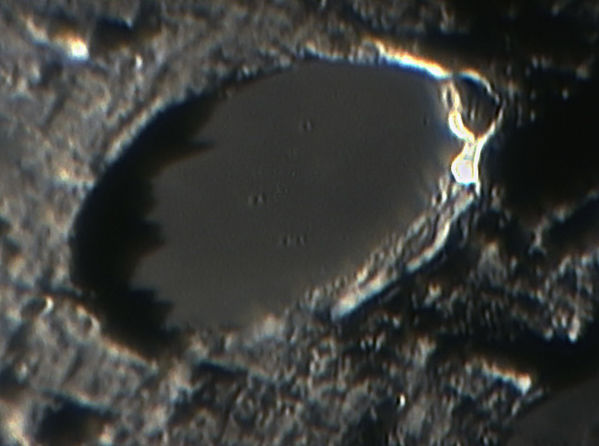On the plane returing from the SAP Sapphire conference in Atlanta, I was reading Sky & Telescope. In the section on Exploring the Moon. This is a regular feature and I’d link to it, but they don’t carry the story on-line, or at least not yet. It seems that is the magazine only available to April and I was reading the May edition.
It was an interesting article about the discovery of small craters on the floor of the crater Plato. Plato is a large, flat-bottomed crater near the top of the Moon, in about the center. This discovery, the article said, started a great series of discoveries of other craterlets and even transient phenomenon. At the time, people believed that the craters on the Moon were volcanic; today we know they are impact craters as the Moon has been dormant for several billion years. Altogether fun to read about the craterlets and something to look forward to seeing.
I had that opportunity last night. Having arrived in late afternoon, I was home for dinner. After dinner, I was outside with my daughter playing and I noticed the Moon. Here was my opportunity. I opened the observatory and started up the scope. There were some high clouds, so I didn’t expect great seeing and therefore I did not worry too much about scope cool down.
The Moon was one day after the first quarter, with the terminator just past the mid-line. Observing with a 22mm eyepiece (127x magnification), Plato was nicely visible, just on the light side of the terminator. Plato looked flat at first, but at select moments of still air, a craterlet would appear. It was quite exciting to see something I had read about just hours earlier. I really only saw one craterlet. At higher magnification, using a 3x barlow, the poor seeing was much worse, and the craterlet winked in and out of visibility. I can understand why people saw these objects as transient phenomenon.
I had not planned to image that night, but the web cam was handy and easily set-up. I took one AVI of about 90 seconds. After processing in Registax, PixInsight, and Photoshop, I got the following result.

There are six craterlets that I could find, four easily. These larger craterlets are from 1.7 to 2.4 kilometers in diameter.
The right side of the image is sharper because I had real trouble with Registax’s tracking and aligning except when I used a single, very large alignment box. That selected frames that were clear on the right, without regard to the clarity on the left. Hence, the right is clearer. In addition, I used sigma reject in Registax to reduce the effect of a bad pixel on my web camera.
